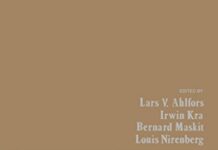
Ebook Info
- Published: 2006
- Number of pages: 162 pages
- Format: PDF
- File Size: 5.49 MB
- Authors: Lars V. Ahlfors
Description
Lars Ahlfors’ Lectures on Quasiconformal Mappings, based on a course he gave at Harvard University in the spring term of 1964, was first published in 1966 and was soon recognized as the classic it was shortly destined to become. These lectures develop the theory of quasiconformal mappings from scratch, give a self-contained treatment of the Beltrami equation, and cover the basic properties of Teichmuller spaces, including the Bers embedding and the Teichmuller curve. It is remarkable how Ahlfors goes straight to the heart of the matter, presenting major results with a minimum set of prerequisites. Many graduate students and other mathematicians have learned the foundations of the theories of quasiconformal mappings and Teichmuller spaces from these lecture notes. This edition includes three new chapters.The first, written by Earle and Kra, describes further developments in the theory of Teichmuller spaces and provides many references to the vast literature on Teichmuller spaces and quasiconformal mappings. The second, by Shishikura, describes how quasiconformal mappings have revitalized the subject of complex dynamics. The third, by Hubbard, illustrates the role of these mappings in Thurston’s theory of hyperbolic structures on 3-manifolds. Together, these three new chapters exhibit the continuing vitality and importance of the theory of quasiconformal mappings.
User’s Reviews
Editorial Reviews: Review “The lectures and supplements constitute a very efficient way of learning some complicated theories with numerous applications.” —- EMS Newsletter”Most library copies of the first edition are now very well-thumbed from use by generations of mathematicians, so this second edition is very welcome. … The second edition is made much more valuable by the addition of three new chapters by leading authorities in fields where quasiconformal mappings have proved especially fruitful.” —- Mathematical Reviews
Reviews from Amazon users which were colected at the time this book was published on the website:
⭐So many people have no published their takes on Quasiconformal geometrythat this book is an eye opener for me. One of his first examples is a square toa rectangle as a mapping…I’m still reading the book: for me it is slow going and the additional chapters , specifically the Hubbardarticle make me reduce the review to four stars as he gives several Kleinian group pictureswithout equations or even traces, making the water cloudy that Ahlfors had been clearing up.I may really change this review as I read this book further. The complex dynamics take onQuasiconformal sets is pretty different than the Kleinian group one and the bridgebetween isn’t cleanly explained most of the time.
⭐Classic notes on quasiconformal mapping. Uses definitions that are less common nowadays, and Ahlfors in his characteristic way leave many things unexplained. Overall, a great book. The additions at the are also excellent surveys of the booming research areas related to qc. The one by Hubbard is especially nice.
⭐The author introduces the study of quasiconformal mappings as natural generalizations of conformal mappings, as mappings less rigid than conformal mappings, as mappings important in the study of elliptic partial differential equations, as generating interesting extremal problems, as important in moduli theory and Fuchsian and Kleinian groups, and as mappings that are better behaved in the context of several complex variables. This short book gives a general overview of the important properties of quasiconformal mappings, with these goals and properties in mind. As the author notes, quasiconformal mappings were introduced by the mathematician H. Grotzsch in 1929 as mappings that are as close to conformal as possible, but that can, for example, take a square in the plane and map it to a (non-square) rectangle in the plane, mapping vertices onto vertices in the process. Conformal maps cannot do this, and a measure of how far the quasiconformal map is from being conformal involves the calculation of the dilatation at a point. The dilatation is computed by considering the effect that the linearization of a C1 homeomorphism has on circles. Such circles are mapped to ellipses, and the ratio of the major to the minor axis gives the dilatation. The dilatation is 1 for a conformal mapping. Following Grotzsch, a mapping is then said to be quasiconformal if the dilatation is bounded, and K-quasiconformal if the dilatation is less than or equal to K. For a family C of curves in the plane, the author introduces the extremal length of C, and shows that it is invariant under conformal mappings and “quasi-invariant” (multiplied by a bounded factor) under quasiconformal mappings. And following precedents from harmonic analysis, the author defines the Dirichlet integral, and shows it to be quasi-invariant under quasiconformal mappings. A more general definition of a quasiconformal mapping is then given, that relaxes the Grotzsch requirement that the mappings be C1. A (topological) mapping is called K-quasiconformal if the “modules” of quadrilaterals are K-quasi-invariant. Quadrilaterals are defined to be Jordan regions with a pair of disjoint arcs on the boundary. The “module” is then defined to be the ratio of the sides of the rectangle that the quadrilateral is mapped to conformally. A 1-quasiconformal mapping is shown to be conformal under this new definition. This “geometric” definition of quasiconformal is followed by an “analytic” one, namely that a (topological) mapping is K-quasiconformal if it is “absolutely continuous on lines”, with another condition that the ratio of its complex derivatives must be bounded by (K-1)/(K+1). A function on a region is “absolutely continuous on lines” if it is absolutely continuous on almost every horizontal and vertical line of any rectangel in the region. The author proves that the geometric and analytic definitions are equivalent. The author then considers three different extremal problems for a doubly-connected region in a finite plane. The problem of finding the largest value of the module of this region is considered for three different conditions on this region and its bounded and unbounded components. Simple relations are shown to exist between the three different extremal modules. Also, and very interestingly, the author gives a connection between these extremal modules and elliptic curves. Mori’s theorem is also proved, which gives a “Holder inequality”, i.e. information on the “stretching” ability of K-quasiconformal mappings of the open unit disk to the open unit disk. This then allows a homeomorphic extension to the closed disk. The author then shows that K-quasiconformal mappings of the unit disk unto itself form a sequentially compact family with respect to uniform convergence. He then considers the question as to when quadruples of distinct complex numbers can be mapped to each other under K-quasiconformal mappings. These results naturally set up a study of the boundary value properties of quasiconformal mappings. The author proves an “M-condition” that is satisfied by a boundary correspondence mapping. This condition involves the parameter K, and the author shows that the boundary values of a K-quasiconformal mapping must satisfy this condition. He then studies the extent to which quasiconformal mappings are isometries, called “quasi-isometries” where distances are multiplied by a bounded factor. The author then gives an interesting discussion as to the geometric properties of curve that the real line gets mapped to when a quasiconformal mapping of the entire complex plane is considered. Attention is then concentrated on proving the existence of quasiconformal mappings with a given complex dilatation. This entails a solution of the Beltrami equation, and for this purpose the author constructs two different integral operators, one of which acts on Lp functions for p > 2, the other acting on C2 functions with compact support. All of his discussion has the flavor of classical harmonic analysis, with detailed attention given to the proof of the Calderon-Zygmund inequality. The author ends his book with a consideration of Teichmuller spaces, with attention given to the extent to which the classical theory of conformally equivalent Riemann surfaces can be generalized to the context of quasiconformal mappings. The Teichmuller space is thus defined as the collection of pairs of Riemann surfaces and sense-preserving quasiconformal mappings between them, with pairs being equivalent under homotopy. The familiar Beltrami and quadratic differentials make their appearance, and the image of the mapping of the unit ball of Beltrami differentials to the spece of quadratic differentials is shown to be open. The Teichmuller space is then shown to be an open subset of the space of quadratic differentials, with the Teichmuller metric giving the same metric as the norm in the space of quadratic differentials. This space has dimension 3g – 3 when the starting Riemann surface has genus g, and with respect to the parameters of the basis of this space, one obtains a holomorphic family of Riemann surfaces.
⭐Ahlfors, of course, was one of the great mathematicians of the 20th century and made landmark contributions to several fields related to complex analysis, including the field of quasiconformal mappings. It feels almost heresy to give this book anything less than a perfect, five star rating.Still, this book can be at times more frustrating than helpful. It has a tendency to use very specific notation from an earlier section without warning. Some details, such as the definition of module (conformal modulus) at the start of Chapter 3, seem missing altogether. Many sections will likely be confusing the first time or two, mainly because the level of detail is quite sparse. (Then again, it’s telling that at various points the editors have added footnotes to fill in significant omissions from the arguments.)It is nevertheless a useful and enjoyable book, in that you get a firsthand glimpse into the theory while still mid-development, you get the same content as some of Ahlfors’s papers while packaged into a more self-contained exposition, and you find some “hard analysis” arguments (for example, using elliptic functions) that seem to be deemphasized in more recent books. I probably wouldn’t recommend it as a first text, but for a serious student of the subject it’s worth reading eventually.
Keywords
Free Download Lectures on Quasiconformal Mappings (University Lecture Series) 2nd Edition in PDF format
Lectures on Quasiconformal Mappings (University Lecture Series) 2nd Edition PDF Free Download
Download Lectures on Quasiconformal Mappings (University Lecture Series) 2nd Edition 2006 PDF Free
Lectures on Quasiconformal Mappings (University Lecture Series) 2nd Edition 2006 PDF Free Download
Download Lectures on Quasiconformal Mappings (University Lecture Series) 2nd Edition PDF
Free Download Ebook Lectures on Quasiconformal Mappings (University Lecture Series) 2nd Edition


